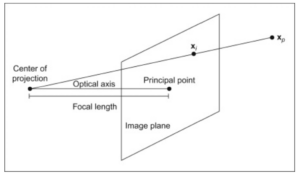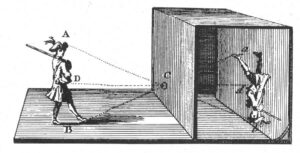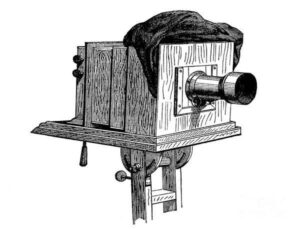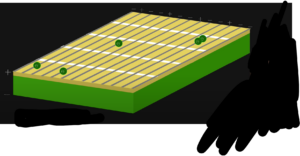Abstract
The motion picture camera lies at the center of the film industry, but what lies inside this seemingly trivial invention? This modern device has its origins set in the fifth century BCE with the camera obscura – a dark room where light enters through a single pinhole – which takes advantage of optics to produce virtual images of its surroundings. The camera obscura evolved over centuries into analog cameras capable of saving images onto film or glass plates through a series of chemical processes. Further on, a researcher named Eadward Muybridge built on these techniques to create the first motion picture camera with the ability to capture and display movement. As technology progressed and the film industry entered the modern era, these ideas were translated into digital cameras that now store images as electrical signals in computer memory. The evolution of the camera exemplifies a story of the disparate fields of engineering coming together to achieve innovation and bring the magic of movies to audiences everywhere.
Keywords
Film, Optics, Camera Circuitry
Lights! Camera! Action! The cinema world brings together people from a variety of fields and backgrounds; from the actors who bring to life new characters on screen and the screenwriters who imagine the most ingenious stories, to the graphics experts who animate the impossible. However, the entire film industry revolves around the seemingly simplest tool on set: the camera. While the modern age has brought cameras into the palm of our hands, this phenomenon is, in reality, a feat of engineering centuries in the making.
The Birth of the Camera
The original camera, a masterpiece of physics and engineering, was nothing more than a hole. The camera obscura, first recorded in the texts of Chinese philosopher Mozi in the fifth century BCE, literally translates from Latin as “dark chamber” and was initially used as a drawing aid for artists attempting to capture the outdoors [1]. The camera obscura was a dark room with a single small pinhole on one side – and as if through magic, that small pinhole produced a scaled inverted image of the outside on the opposite side of the room. So how was that tiny aperture able to project an image? The magic is in the optics.
The pinhole acts as a center of projection, through which light rays can pass. According to the physics of optics, light passing through the aperture will exit at the same angle it enters and will travel the same distance beyond the aperture as its distance from the pinhole [2]. Figure 1 demonstrates this phenomenon in a simplified setting.

Figure 1 – A simplified diagram of the optics behind the camera obscura [2]
Light from the outside passes through the pinhole at the center of projection and travels onto the image plane. To understand this phenomenon further, imagine a small insect on the ground 10 meters away from the pinhole. The visible light from the insect will travel up to the center of projection. Once that light passes through the pinhole, it exits at the same angle; so, the insect’s image will continue to travel along its trajectory 10 meters behind the center of projection onto the image plane, now above the pinhole. As a result, light entering from a height above the aperture will exit below on the opposite side of the hole, causing the image to be inverted, or upside-down, as seen in Figure 2.

Figure 2 – A demonstration of the camera obscura [3]
However, if we follow the definition described above, objects located far away would land far behind the aperture, likely beyond the size of the room. These faraway points are actually projected onto the image plane, which in this case is the back wall of the chamber. This results in a phenomenon known as “lateral transposition,” which defines the back-to-front effect within the resulting image [2]. Hence, objects far away from the aperture seem further back on the wall, allowing the virtual image created by the camera obscura to maintain correct perspective and size ratios. Artists are then able to take advantage of this lateral transposition to scale the image created as they see fit, a feature we know today as “zoom.” By decreasing the distance between the pinhole aperture and the image plane, known as the focal length, the distance between a point’s trajectory and the back wall is reduced, allowing for more points to fit on the image plane and therefore allowing a zoomed-out image to fit within the same area.
The last feature of the camera obscura is its aperture size. Increasing the size of the aperture allows more light to pass through, creating a brighter image but one that is blurrier than before. This happens due to a phenomenon known as diffraction, where light bends as it passes an object [2]. This bending effect is dampened when less light can pass through the pinhole, meaning a small aperture will create a sharper image that is dimmer. Any photographer reading this may recognize a few key words from the camera obscura that can be found on the latest, state-of-the-art cameras in the market, particularly aperture and focal length. The rudimentary design of the camera obscura takes advantage of the physics of light by manipulating these two parameters and serves as a basis for modern motion picture technology.
The First Motion Picture

Figure 3 – A drawing of a glass plate camera from the 1880s [4]
Fast forward to 1872, where the camera obscura was replaced with a glass plate camera like the one shown in Figure 3. Governor Leland Stanford and his friend, a fellow horse racing enthusiast, had a wager on when a horse runs, are all four feet ever off the ground at once? Stanford decided to pay $25,000 to Eadward Muybridge, a researcher in Bell Labs at the time, to settle the bet, and the first motion picture camera was born. In his experiment, Muybridge set up several glass-plate cameras along the edge of the track, where each camera’s shutter was to be triggered as Occident, Stanford’s prize horse, ran past. Muybridge lined the track with cloth sheets in order to reflect enough light to capture the photos, and displayed the resulting images on a device he invented known as the zoopraxiscope [5]. And thus, Muybridge finally settled the wager; all he had to do was to stop on one of the stills shown in Figure 4 of the horse’s run where all four feet were off the ground, and Stanford was proven correct.

Figure 4 – Camera frames from Muybridge’s experiment [6]
Though Muybridge’s experiments may seem like only a story, they represent a significant moment in cinema history, one where the idea of a moving picture became a reality through impressive advancements in chemical engineering and materials science. An image taken with a camera like Muybridge’s consists of two parts: a thin, light-sensitive emulsion layer supported by a base layer, such as paper or metal [7]. In Muybridge’s camera, the glass plate serves as the base, which is exposed to light for a fraction of a second when the shutter of the camera opens. Spread on top of the plate is a compound known as collodion, a composite of several chemicals including cellulose nitrate, gelatin, and, most importantly, a silver halide [8]. Silver halides have a unique crystalline structure. As a result, when light photons come into contact with this compound, the extra energy causes the structure to break and releases free electrons which migrate to areas of the emulsion layers known as “sensitivity specks,” causing a chemical reaction where electrons bond with silver ions to create silver atoms. As more light is exposed to this sensitivity speck, more silver atoms will populate that area of the base [9]. For instance, imagine that exposing the emulsion layer to light is like stamping ink onto a paper. Areas where the stamp contacts the paper with more pressure leave more ink than the raised portion of the stamp. Similarly, areas of the chemical layer with greater exposure to light contain more silver atoms, which together form a latent image on the glass plate.
The image is now embedded in the chemical layer of the glass plate, but still invisible to the human eye. In order to reveal the image hidden behind the chemical composition, the glass plate undergoes a process called “developing.” When this plate is placed in a bath of a developing agent, the sensitivity specks are amplified to a point where exposed areas of the plate turn black. Non-exposed areas are still covered with silver halides, which are then removed by placing the glass plate in a “fixing” agent that dissolves the crystals and leaves on the black silver grains in what is known as the photo’s “negative.” By placing a piece of printing paper beneath the negative and exposing it to light, the light shone through the negative will invert the colors and produce the final image, the “positive” [9].
This process enabled Muybridge to capture stills of the horse in motion, or frames of the video. And to present his findings as a moving picture, he later designed the zoopraxiscope. Muybridge would hand-paint glass plates traced over the images he had taken with the camera and shine a light through them [5]. Since each still was composed of consecutive images of the horse’s run within a close timeframe, and the zoopraxiscope rotated through the images, Muybridge was able to effectively record and display the horse’s run.
Coming to a Theater Near You
Stanford’s friendly wager paved the way for the film industry and led to the creation of the motion picture film camera. This design, innovated and iterated on throughout the 19th century, reveals an intricate mechanical process that implements the recording process. First, the shutter opens, exposing the light-sensitive film to the image, and closes. This film paper is guided through the camera by a sprocket system, giving film strips their iconic sprocket holes that line the top and bottom edges. The sprocket system pulls a new, unexposed area of the film paper from the canister behind the shutter and moves the exposed frame into the rear magazine where it cannot be exposed to light further and will maintain the latent image on the chemical layer [10]. The typical camera can execute this load-expose-reload cycle at a rate of 24 frames per second, which can then be developed into film negatives and positives as needed.
Cinema Today and the Modern Digital Camera
While the film camera is still held in high regard by filmmakers like Quentin Tarantino and Christopher Nolan, the industry has seen a substantial shift toward digital cameras. Their ability to avoid physical degradation and simplify the editing process have made digital cameras a compelling and affordable alternative to physical film cameras. But these cameras require intricate circuitry and substantial innovation to move the analog process into the digital era.
The key ingredient of the digital camera is silicon, a semiconductor with the ability to form complex crystal structures with other silicon atoms. In a process called “doping,” these silicon crystals can become positively or negatively charged by adding a small amount of phosphorus or boron respectively to create P-Type and N-Type semiconductors [11]. Together, a P-Type and N-Type semiconductor can form a diode [11], a circuit element that allows an electric current to flow from the positive P-Type end to the negative N-Type end. Furthermore, silicon also facilitates the photoelectric effect, since silicon reacts with light within a broad range of wavelengths, including visible light. When the photoelectric effect takes place, photons are absorbed by the silicon crystal, and the added energy causes a current to flow through the diode and move electrons toward the positive end [11]. In turn, we can then measure the intensity of light exposed on a particular area as the number of electrons that are concentrated at the positive end of the diode, also known as the voltage.
Two researchers at AT&T Bell Labs in 1969, Williard Boyle and George Smith, took advantage of these unique electrical properties of silicon to invent the CCD: the Charged Coupling Device. A CCD is simply a slab of P-N silicon, which contains insulated channel stops that prevent the flow of current between columns and perpendicularly placed thin strips of aluminum [11]. As a result, the slab of silicon can be divided into a grid of pixels, where each pixel contains a portion of the silicon between two insulating stops and three rows of aluminum strips. When the shutter opens and exposes the silicon slab to light, the photoelectric effect takes place, causing electrons to migrate to the top and bind to the aluminum strips as shown in Figure 5 [11]. Once the shutter closes, the electrons settle in their place and the camera now holds a latent image – stored in the electrical signals rather than the chemical composition. The electrons on the aluminum strips are stored in a capacitor (a circuit element designed to store charge) and are then amplified and transferred into the camera’s computer memory [11]. The result of this intricate electrical process seems once again like magic: an ability to capture and store the image frames in digital memory rather than physical film paper.

Figure 5 – The silicon slab, with electrons binding to the aluminum strips [12]
CCDs revolutionized the digital camera but still suffered from several issues including large power requirements and slow processing speeds. To address these problems, American physicist and engineer Eric Fossum invented Complementary Metal-Oxide Semiconductor (CMOS). CMOS employs a similar construct to CCDs, but instead of storing and amplifying one by one as CCDs do, each pixel has a built-in capacitor and amplifier to execute this process in parallel [11]. In other words, the CMOS hardware could load each of the pixel’s data, stored as electrons on the aluminum strips, into the camera’s memory chip in one shot as opposed to the sequential process in CCDs. This parallelization allowed for much lower power requirements and much faster image capture. CMOS quickly outsold CCDs, and with modern advancements in manufacturing capabilities, it has since become the most proliferated image sensor in the digital camera market.
Conclusion
The motion picture camera has been a device centuries in the making, and the cinema industry has long relied on engineering to improve and innovate on its design. The camera obscura employed physics principles of optics to project its image, film photography required years of innovation in chemical and materials engineering to perfect the development process, mechanical sprocket systems made the analog motion picture camera possible, and electrical circuitry brought the recording camera into the modern age. By journeying through the storied past of the cinema, we realize that the evolution of the camera is a story of engineers who have set the stage for the film industry.
Bibliography
[1] “Camera Obscura,” www.nga.gov. https://www.nga.gov/press/exh/2866/camera-obscura.html#:~:text=A%20forerunner%20of%20the%20modern
[2] M. S. Nixon and A. S. Aguado, “Chapter 10 – Appendix 1: Camera geometry fundamentals,” ScienceDirect, Jan. 01, 2012. https://www.sciencedirect.com/science/article/abs/pii/B9780123965493000161 (accessed Oct. 04, 2023).
[3] “How do Artists use the Camera Obscura,” Lensbaby. https://lensbaby.com/blogs/creative-photography/artists-using-obscura
[4] “Glass Plate Camera, 1880s Poster by Bildagentur-online,” Fine Art America. https://fineartamerica.com/featured/glass-plate-camera-1880s-bildagentur-online.html?product=poster (accessed Oct. 22, 2023).
[5] “Eadweard Muybridge Produces the First Photographs of Motion : History of Information,” www.historyofinformation.com. https://www.historyofinformation.com/detail.php?id=3667#:~:text=to%20settle%20a%20debate%20whether
[6] “The Horse in motion. ‘Sallie Gardner,’ owned by Leland Stanford; running at a 1:40 gait over the Palo Alto track, 19th June 1878 / Muybridge.,” Library of Congress, Washington, D.C. 20540 USA. https://www.loc.gov/item/97502309/
[7] “How Stuff Works: The Science of Film Photography – The Tartan,” thetartan.org. http://thetartan.org/2019/2/18/scitech/how-stuff-works#:~:text=When%20light%20hits%20the%20film (accessed Oct. 04, 2023).
[8] “How Glass Plate Negatives were made,” Poultney Vermont Historical Society. https://www.poultneyhistoricalsociety.org/exhibitions/glass-plate-negatives/historical-photography#:~:text=This%20early%20photographic%20technique%20invented
[9] “Canon : Canon Technology | Canon Science Lab | Photographs,” Canon Global. https://global.canon/en/technology/s_labo/light/003/01.html#:~:text=Camera%20film%20uses%20silver%20halides (accessed Oct. 04, 2023).
[10] “Who Invented the First Motion Picture Camera?,” TheCollector, Jun. 29, 2023. https://www.thecollector.com/who-invented-the-first-motion-picture-camera/
[11] “Imaging Electronics 101: Understanding Camera Sensors for Machine Vision Applications,” www.edmundoptics.com. https://www.edmundoptics.com/knowledge-center/application-notes/imaging/understanding-camera-sensors-for-machine-vision-applications/
[12] “The Science of Camera Sensors,” www.youtube.com. https://www.youtube.com/watch?v=MytCfECfqWc



